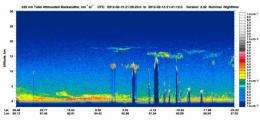Scientists use new method to zero in on source of tropical clouds

(Phys.org) -- High above the Earth, clouds too thin to see cover the tropics. Scientists at Pacific Northwest National Laboratory have found a creative technique to identify the clouds' origins. Using several satellite data sources, they identified cloud formation mechanisms that occur in two distinct conditions. Knowing the different formation mechanisms will help scientists predict the amount of water vapor in the upper atmosphere, which affects the balance of warming and cooling that determines the Earth's climate. Their research was published in the Journal of Geophysical Research.
Like a middle-aged pudge, the Earth's atmosphere is a bit thick around the equatorial middle. Clouds at the height of this bulge are so high and wispy they are invisible to the human eye. Nevertheless, the water content in these clouds has a greenhouse effect on the climate, letting sunlight pass down to warm the surface but not letting heat reflected from the surface escape. Because these clouds blanket vast areas of the tropics, the heating effect influences long-term climate changes. Scientists are pinpointing the source of these clouds to quantify water vapor in the upper atmosphere, which helps with climate change predictions.
Tropical Tropopause Layer Cirrus (TTLC) clouds are so high in the atmosphere and so thin their formation can't be seen with the eye, and current instrument detection methods only capture a one dimensional picture of the clouds. Scientists at PNNL devised a novel method to detect how the clouds are formed.
Typical identification of TTLC formation has been through statistical methods using correlations of temperature and the frequency of the TTLC, or using back trajectories of TTLC that eventually traced to convection. In this study, the researchers compared the "object classification" detection method, which combined adjacent Cloud-Aerosol LiDAR and Infrared Pathfinder Satellite Observation (CALIPSO) profiles to identify the clouds as objects, and the statistical and back trajectory methods.
Using three years of CALIPSO data they identified optically thick clouds in the layer, which in the tropics are associated with deep convection. Classifying the cloud "objects" as either convective or non-convective, they were able to classify which clouds are formed from anvil clouds that can increase water vapor, or formed in situ in supercooled conditions that can dry out the layer.
Using the frequency of different cloud formation mechanisms calculated in this research, future studies can make more accurate calculations of the climate impacts of these clouds through humidity and atmospheric heating near the tropopause.
More information: Riihimaki LD, SA McFarlane, C Liang, ST Massie, N Beagley, and TD Toth. 2012. "Comparison of Methods to Determine Tropical Tropopause Layer Cirrus Formation Mechanisms," Journal of Geophysical Research, 117, D06218, DOI:10.1029/2011JD016832
Journal information: Journal of Geophysical Research
Provided by Pacific Northwest National Laboratory


















